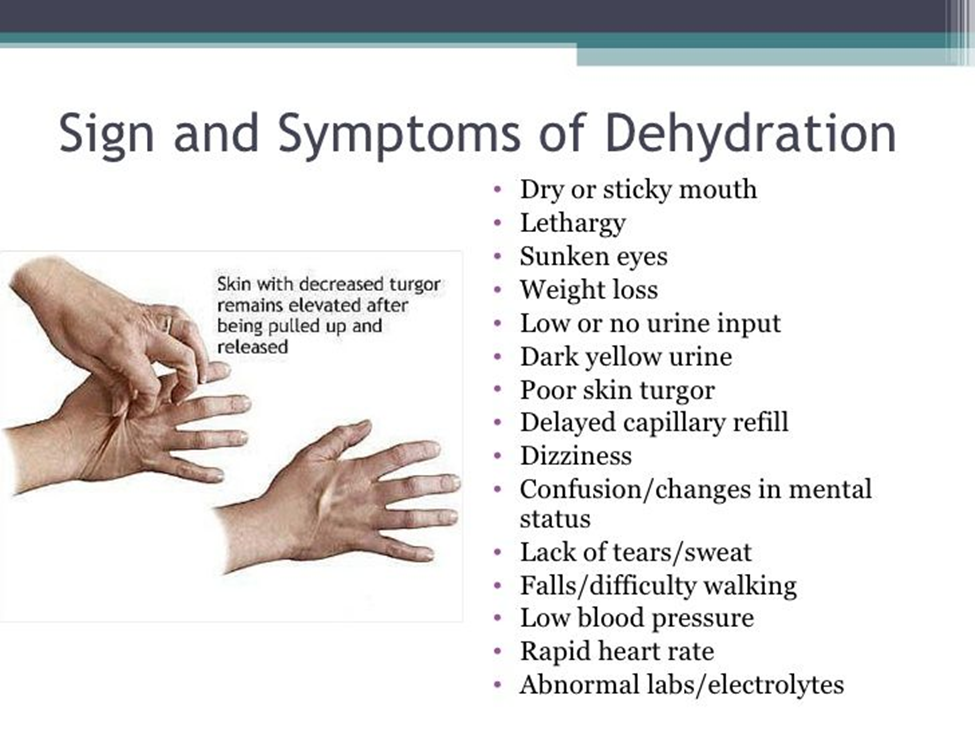A nurse in a community clinic is collecting data from an older adult client who has a body mass index of 17.5. When evaluating the client for dehydration, the nurse should look for which of the following indications of fluid-volume deficit?
Tenting
Protruding eyeballs
Elevated blood pressure
Dry mucous membranes
The Correct Answer is A
A. Tenting
Tenting refers to the delayed recoil of the skin when pinched. In a dehydrated state, the skin loses elasticity, leading to tenting due to decreased skin turgor. This is a specific sign of fluid-volume deficit.
B. Protruding eyeballs
Protruding eyeballs are not typically associated with dehydration. This could be related to other conditions such as thyroid dysfunction, but it is not a specific indicator of fluid-volume deficit.

C. Elevated blood pressure
Elevated blood pressure is not a typical sign of dehydration. In fact, dehydration often leads to a decrease in blood pressure due to reduced blood volume.
D. Dry mucous membranes
Dry mucous membranes can be an indication of dehydration, but in the context of the question, tenting (Option A) is a more specific sign related to skin turgor and is commonly assessed when evaluating for dehydration.
Nursing Test Bank
Naxlex Comprehensive Predictor Exams
Related Questions
Correct Answer is D
Explanation
A. Drink carbonated beverages.
Carbonated beverages may cause bloating and gas, which can be uncomfortable for individuals with COPD. It's generally advisable to choose non-carbonated and non-caffeinated beverages.
B. Decrease fiber intake.
Decreasing fiber intake is not a recommended approach for individuals with COPD. Fiber is important for digestive health and overall well-being. A balanced diet, including adequate fiber, is generally encouraged.
C. Use bronchodilators after meals.
The timing of bronchodilator use is typically based on a schedule or as needed for symptom control, rather than being specifically linked to mealtime. It's important to follow the healthcare provider's instructions regarding the use of bronchodilators.
D. Increase protein intake.
Increasing protein intake is an appropriate nutritional recommendation for individuals with COPD. Protein is important for maintaining respiratory muscle strength and overall health.
Correct Answer is C
Explanation
A. The stockings are used to reduce pain.
This statement is not accurate. While antiembolism stockings may provide some relief from discomfort and swelling, their primary purpose is to prevent venous stasis and reduce the risk of blood clots, not to directly reduce pain.
B. The stockings prevent varicose veins.
This statement is not entirely accurate. While compression stockings can provide some support to veins, their primary role is in preventing blood clots (venous thromboembolism) rather than preventing varicose veins, which are typically related to venous insufficiency.
C. The stockings prevent venous stasis.
This is the correct answer. Antiembolism stockings are specifically designed to prevent venous stasis, which refers to the slowing or stagnation of blood flow in the veins. They exert gentle pressure on the legs to enhance blood circulation and reduce the risk of blood clots.
D. The stockings replace the need for postoperative leg exercises.
This statement is not accurate. While antiembolism stockings are a preventive measure, they do not replace the need for postoperative leg exercises. Leg exercises are important for promoting circulation, preventing complications such as deep vein thrombosis (DVT), and maintaining overall mobility after surgery.
Whether you are a student looking to ace your exams or a practicing nurse seeking to enhance your expertise , our nursing education contents will empower you with the confidence and competence to make a difference in the lives of patients and become a respected leader in the healthcare field.
Visit Naxlex, invest in your future and unlock endless possibilities with our unparalleled nursing education contents today
Report Wrong Answer on the Current Question
Do you disagree with the answer? If yes, what is your expected answer? Explain.
Kindly be descriptive with the issue you are facing.
